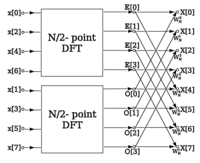
Photo from wikipedia
Transform model estimation (TME) is a geometric operation, widely utilized in real-time imaging systems. Considering the massive computational load of matrix algebra-based TME realizations, most of the imaging systems resort… Click to show full abstract
Transform model estimation (TME) is a geometric operation, widely utilized in real-time imaging systems. Considering the massive computational load of matrix algebra-based TME realizations, most of the imaging systems resort to highly paralleled software-platform-based TME execution, which is power-intensive and expensive. Due to low-speed and power intensiveness, existing hardware for TME is not capable enough to meet the requirements of real-time systems. In this article, a hardware-realizable method of three-degree-of-freedom TME is formulated encompassing both the conventional CORDIC and the proposed modified CORDIC. The novelties of the proposed TME method and the corresponding architecture are that its latency sublinearly varies with the precision and the total computation time (CT) is almost independent of the input image sizes. The performance of prototype 16-bit fixed-point TME architecture (realized using VHDL in Xilinx Vivado 18.2) is compared with the software-counterpart. The proposed TME hardware is utilized along with other standard hardware modules to realize image registration (IR) operation. The proposed IR architecture achieves, on average, 60% reduction in total CT, $1.61 \times $ increase in maximum operating frequency with a comparable accuracy, only at the cost of 23% increase in power consumption with respect to other existing IR hardware.
Journal Title: IEEE Transactions on Very Large Scale Integration (VLSI) Systems
Year Published: 2021
Link to full text (if available)
Share on Social Media: Sign Up to like & get
recommendations!